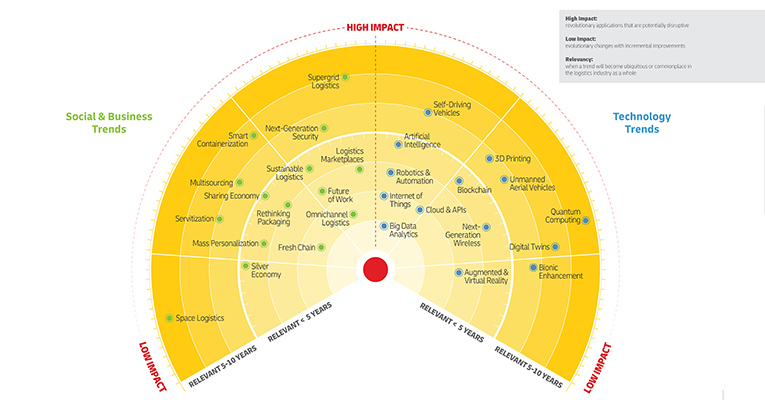DHL lists 15 business, 14 tech trends to shape future of logistics
September 24, 2020: In the fifth edition of the Logistics Trend Radar, DHL has revealed 29 key trends (15 social and business trends, 14 technology trends) that will impact the logistics industry over the next years.

September 24, 2020: In the fifth edition of the Logistics Trend Radar, DHL has revealed 29 key trends (15 social and business trends, 14 technology trends) that will impact the logistics industry over the next years.
“From cloud computing to collaborative robotics, big data analytics, artificial intelligence, and the Internet of Things, logistics professionals have to make sense of a vast market of novel technology. Modernizing all touchpoints of supply chains, from an elegant digital or customer journey, through fulfilment transport and final mile delivery is the new imperative for long-term success. Those who adopt and scale new technology and upskill workforces fastest will have a competitive advantage on the market,” noted the release.
Katja Busch, chief commercial officer, DHL, said, “The megatrends that will continue to engage us are not unfamiliar: new technologies, growing e-commerce and sustainability. But some areas will evolve faster than others.”
Matthias Heutger, senior vice president, global head of innovation & commercial development at DHL, said, “The next big challenge will be future-proofing the logistics workforce through training and upskilling in increasingly technologically sophisticated operations. This will take centre stage on the strategic agendas of supply chain organizations in the years to come. In this edition, we already see the impact of Covid-19 is accelerating trends that were already well underway – big data analytics, robotics and automation, and IoT, all of which are underpinned by steady progress in artificial intelligence.”
Few interesting trends include:
Quantum Computing
Millions of times faster than supercomputers, quantum computers will unlock an unprecedented level of calculating power capable of processing highly complex logistics algorithms in real-time and rapidly simulating and iterating product and service models for a better-performing supply chain. Like technological breakthroughs before them, quantum computers will also present new opportunities and risks for cybersecurity.
Space Logostics
With the advent of satellite constellations and habitable bases, space logistics is an emerging niche within the industry. While the core of logistics remains the same, whether in space or on Earth, more stringent constraints and extreme conditions challenge the safe transport, storage, and delivery of materials and products beyond Earth’s atmosphere and back.
Supergrid Logistics
Going beyond 4PL logistics and logistics marketplaces, the trend of Supergrid Logistics refers to the next dimension of consolidation, orchestration, and optimization of global supply chain networks, integrating swarms of different production enterprises and logistics providers. This opens up new business opportunities for various players, including established 4PLs, specialized companies, and even small local couriers and startups.
Augumented & Virtual Reality
Blending the digital and physical worlds, augmented reality (AR) can augment logistics quality and productivity, empowering workers with the right information at the right time in the right place. Virtual reality (VR) technology enables logistics providers to design, experience, and evaluate environments in a digital world for optimizing material flows and training processes.



